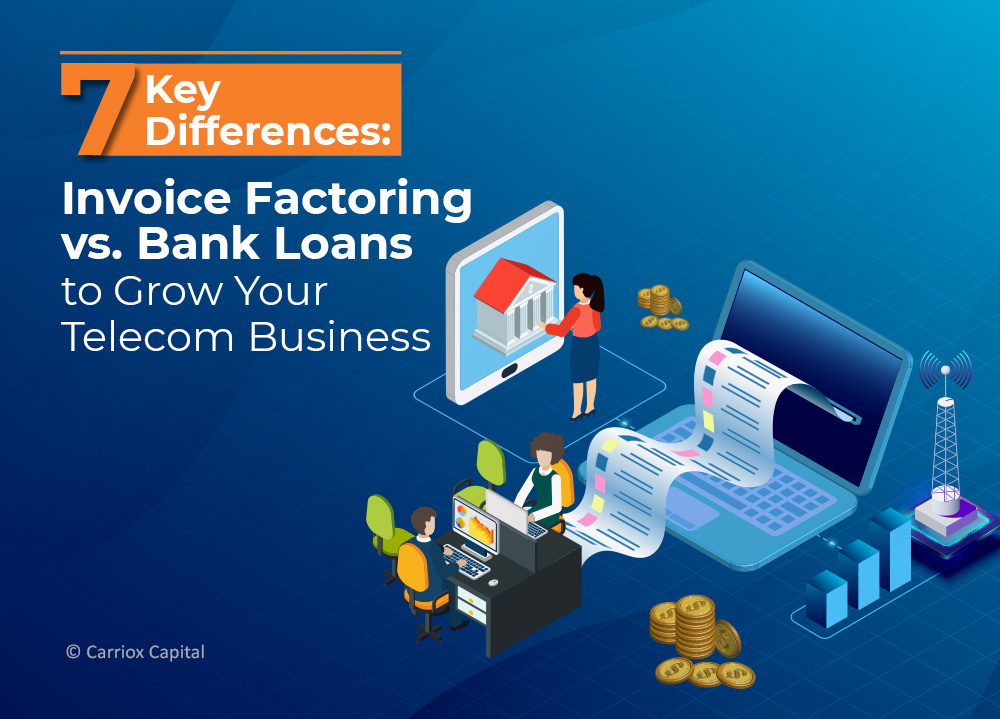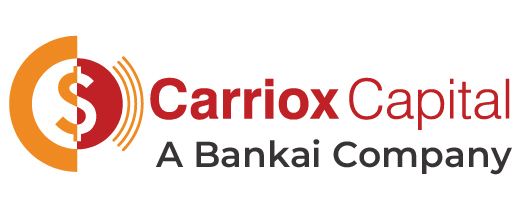Invoice Factoring vs. Bank Loans: 7 Comparisons to Beat Cash Crunch in Telcos

Operators, cell tower constructors, and telco owners relentlessly race against time to bridge the digital divide in this era, where information travels at the speed of light. However, whether it’s the need for immediate funds to cover payroll or take on new projects while retaining loyal customers, the cash crunch issues faced by this industry are no secret.
While traditional bank loans have long been a go-to option for businesses seeking financing, they may only sometimes be suitable for telco companies. Telcos often require on-demand financial solutions that don’t burden their balance sheets with debt. It is where telecom invoice factoring comes into play as a compelling alternative.
5G (excluding cellular IoT) is projected to reach 430 million connections by 2025, comprising approximately 14% of the total connections, highlighting the immense demand for financing. Invoice finance for cell tower construction can provide quick fund disbursement to fuel operations, like acquiring land, obtaining permits, and installing equipment.
Let’s understand the key differences between invoice factoring and bank loans to help you decide which financing option is best for your business.
Step-by-step Process of Getting a Bank Loan for Telecom Businesses
- Conduct thorough research to find the ideal bank for your telecom business.
- Prepare all necessary financial documents, including statements, returns, and bank records.
- Articulate a clear plan for loan utilization and present it to the bank.
- Schedule a meeting with a loan officer, bringing all relevant business and financial documents.
- Complete a comprehensive loan application, providing accurate information and requested details.
- Exercise patience during the bank’s review process, which can take weeks or months.
- If approved, carefully read the loan agreement to understand repayment terms.
- Make timely payments to maintain good standing with the bank and avoid default.
Step-by-step Process of Acquiring Invoice Finance for Cell Tower Construction and Other Telcos
- Identify signs indicating the need for telecom invoice factoring, such as bank rejections and slow-paying clients.
- Contact a reputable factoring company and share crucial business information, including unpaid invoices and customer credit history.
- Complete a comprehensive application, allowing the factoring company to review and match you with an appropriate factor.
- Upon approval, receive a factoring agreement detailing terms, fees, and advance rates.
- Sell unpaid invoices to the factoring company, which will verify and advance up to 90% of the invoice amount.
- The factoring company handles collection efforts with your customers.
- Receive the remaining invoice amount, minus a small factoring fee, after collecting payment.
Invoice Factoring vs. Bank Loans: A Comparative Guide to Funding Your Telecom Business
Debt
Immediate cash can be obtained by selling invoices to a factoring company, eliminating the need for traditional loans and their associated interest payments. This debt-free approach allows telecom businesses to maintain financial flexibility and agility without being burdened by long-term obligations. In contrast, bank loans involve taking on debt, which can impact creditworthiness and add pressure to meet regular payment obligations.
Credit Checks
Factoring places less emphasis on personal and business credit values, instead focusing on evaluating the creditworthiness of a business’s customers. It makes telecom invoice factoring an attractive option for companies with limited credit history or businesses in transition phases. In contrast, bank loans involve extensive credit analysis that scrutinizes the individual and business seeking funding, often leading to stringent credit standards that can hinder access to loans.
Availability of a Reliable Customer Base
While invoice finance for cell tower construction heavily relies on the company’s current accounts receivable invoices, bank financing offers a broader scope of funding options. When a telecom business requires a substantial amount of capital that exceeds the total value of outstanding invoices or when faced with an unreliable customer base, bank loans can be the preferred choice.
Interest Rates and Fees Incurred
With their fixed interest rates and potential for favorable terms during low-rate periods, bank loans offer telecom businesses the stability and predictability needed for long-term growth strategies. While bank loans may involve additional fees such as origination fees, underwriting fees, and prepayment penalties, telecom invoice factoring can also have associated fees, including application fees and transaction fees.
Supplier Discounts
Telecom companies often encounter volume discounts, early payment incentives, and particular supplier offers that can significantly impact their bottom line. However, the time-sensitive nature of these discounts requires immediate capital availability. Unlike bank loans, which can involve lengthy approval processes, invoice finance for cell tower construction and other telecom operations enables businesses to convert their outstanding invoices into cash quickly. This swift access to funds empowers telecom companies to seize opportunities and capitalize on supplier discounts.
New Revenue Opportunities
When invoice factoring takes the lead, telecom companies can significantly reduce the resources spent processing customer invoices and collecting payments. With the burden of invoice processing and collections lifted, telecom companies can redirect their efforts towards critical tasks like expanding their network infrastructure, investing in cutting-edge technologies, and exploring new market segments. In contrast, bank loans don’t provide the same level of assistance in these areas, as the primary focus is securing financing.
Upper Limit
Unlike bank loans that impose strict maximum capital limits, telecom invoice factoring offers the potential for unlimited funding. As long as telecom companies have invoices to sell from creditworthy customers, they can continue accessing funds. The lending power in invoice factoring is directly tied to the size of their accounts receivable, allowing for potentially abundant working capital.
Don’t Let Slow Payments Hold You Back: Grow With Invoice Factoring
Invoice factoring and bank loans present viable options when it comes to financing telecom businesses and beating cash crunches. However, invoice finance for cell tower construction and other telecom operations offers distinct advantages for telecom companies. The ability to swiftly access funds, seize supplier discounts, and redirect resources towards revenue-generating activities allows telecom companies to optimize their growth potential. As the telecom industry races to connect the unconnected and embrace new revenue opportunities, telecom invoice factoring emerges as a compelling financing alternative, enabling telecom businesses to navigate cash crunches and drive innovation.
Carriox helps telecom companies keep their operations afloat and bridge gaps in completing payment cycles by providing quick invoice factoring services at competitive interest rates. Get in touch with us today to learn more.

Nitisha Jain
Nitisha Jain is the Content Manager at Panamax with over 12 years of experience in the industry. She is passionate about creating high-quality, informative, and engaging content for various audiences. In her current role, Nitisha is responsible for developing and executing content strategies for a variety of projects, including blog posts, articles, social media posts, website content, email campaigns, and more. She ensures that all the content published is on-brand and consistent with the company's overall messaging.

